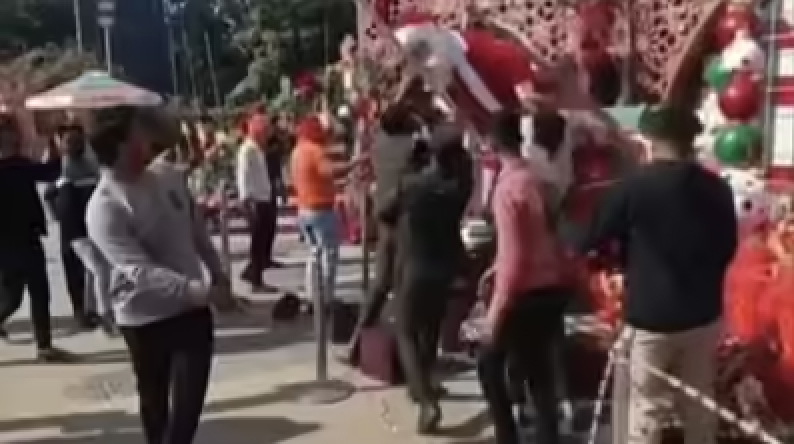Just like Pandit Dhirendra Shastri, popularly known as Baba Bageshwar, Ranchi’s Baba Ramdev has also been raising the demand of a Hindu Rashtra (Hindu nation) for a long time. He insists that the nation is safe only if it is turned into Hindu Rashtra. He has been advocating Hindutva among Adivasis too, through programs organized by Hindu groups in different districts of Jharkhand. The seer preaches about Hindutva and issues related to Hindu religion among Adivasis in these programs.
He tells Outlook that he has been visiting different villages for the past 15 years at the invitation of organizations such as RSS, Hindu groups, and NGOs. Over the course of these years, he has participated in approximately 60 events, where Adivasis have also been present. The most recent event occurred in 2020, prior to the Covid pandemic, and was organized by Vanvasi Kalyan Kendra in a village located in the Bishunpur sub-division of the Gumla district.
“I spoke there on Gau-seva (cow protection). Today, cows are not safe. People are killing them and eating them. I explained how they should understand the importance of (the cow) and protect it. Anybody who attains the 10 attributes of Hinduism, is a Hindu. You may call it Ram-raj (the kingdom of Ram) or Ishwar-raj (the kingdom of God), but its path cannot be hindered (anymore),” he says.
When asked if his programs could help the BJP, as the party’s leaders have also raised demands linked to Hindu Rashtra and Hindutva, Ramdev says, “I am not connected to the BJP or the RSS. But yes, the BJP wants the same things that I do. There should be discussion on Hindutva and Hindu Rashtra.”
He further says that he bound to support the BJP, because the party openly advocates Hinduism, unlike other parties. “Everyone in this country is a Hindu. They should be returned to the fold through Ghar-wapsi (reconversion). And Sarna Adivasis are already Hindus. We are also working among the Adivasis, to bring them closer to Hindutva. The Adivasis in Jharkhand were Hindus earlier, but they have changed a bit due to the spread of Christianity (Christianization),” he says.
The Vanvasi Kalyan Kendra has been active among the Adivasis of Jharkhand, Chhattisgarh and Madhya Pradesh since 1952. This is a frontal organization (anushangik sangathan) of the RSS.
Other Hindu seers have also been raising similar demands in Jharkhand for many years. One of these is Swami Divyanand Ji Maharaj of the Divya Ashram at the Tagore Hill in Ranchi’s Morabadi area. “Baba Bageshwar has only started calling for Hindu Rashtra for the last year or so, but I have been raising this demand for seven years,” he tells Outlook.
Swami Divyanand clarifies that he doesn’t favor any particular political party but supports those who espouse nationalism. “People accuse me of going against the constitution for the establishment of Hindu Rashtra. But it is not so. Yes, we should amend the constitution if it is required for forming a Hindu Rashtra, but this is a mere request or demand from my side. I have not raised a flag for it, I am not violent. Hindu Rashtra means establishing peace. If it is formed, the Hindus and Muslims would live in greater harmony,” he says.
In recent years, Jharkhand has witnessed increased activity and campaigning by Hindu seers, especially between 2014 and 2019, when the BJP was in power in the state with an absolute majority on its own.
IIT Bombay scholar Kunal Shahdeo has been studying the rising graph of Hindutva in the state. He says that while Hindu proselytization and campaigning has been going on in the state for a long time, it has intensified in the last 10 years. The number of organizations and programs has spiked sharply. As a result, temples are being built across villages, and programs being held, he explains.
“The popularity and dominance of Hinduism in the state has surged. An aspect of this is that these kind of religious groups and programs play an important role for the BJP, they prepare a background for the party’s politicking. Even though the BJP lost the last election in Jharkhand, it has increased its dominance in the remote areas of the state, and it seems set to rise further. I think the politics of Jharkhandi and Adivasi identity has failed to counter them (BJP) effectively,” he says.
Shahdeo says that this can be better understood by the votes BJP polled in different assembly elections. In the 2014 elections, the BJP received 31.26 percent votes, and it increased its share by 2.11 percent in 2019 to 33.37 percent. Ten years earlier, the party had managed to get barely 20.18 percent of the votes. This shows that the party has increased its vote share by 13.19 percent in a decade.
The scholar further adds, “When I was working on this topic, I failed to find a single report that would show how many of these new Hindu seers and groups had come up in Jharkhand in the past decade. It is clear that their visibility has increased, but the figures are not available. In contrast, the visibility of Christian missionaries and Islamic groups is much lower, but their numbers can be found easily through the police or other government agencies.”
This story was originally published in outlookindia.com. Read the full story here






